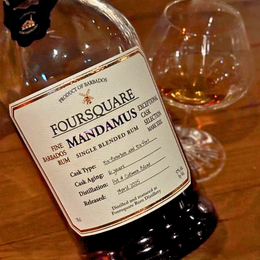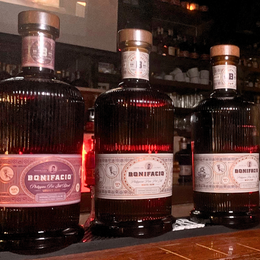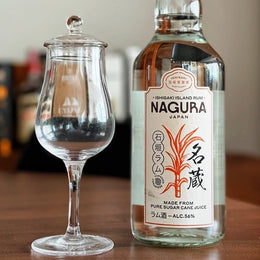Editor's note: This is Part 2 of Jigs' 3-part series on Transcontinental Rum Line (TCRL). Jigs continues his conversation with La Maison & Velier's TCRL brand manager Johann Jobello, and reviews one of TCRL's blended rums. Also check out Part 1 and Part 3 of this series.

[Jigs]: With the variety among rums that you look for, I’m sure that your idea of quality has evolved throughout time. How would you define “quality” in rum, and how does this influence what rum you choose?
[Johann]: “Quality” can mean many different things for us, but it’s something we primarily evaluate by tasting the rum, regardless of its origin or how it was produced. For us, rum has quality if it tastes good. One thing we are adamant about is that when we source rum, we only select non-sugared and natural-color rums. This is something important for us. In the future, I’d like to also take into account additional criteria such as sustainability and worker’s conditions, which are not always easy to incorporate, but I’m trying to work more closely with distilleries, and this will help me gain more information about those criteria. “Quality,” for us, also comes with the ability of rum to communicate a great sense of place. In the end, aside from tasting good, being complex, or having a specific origin, the rum should be delicious and enticing, the kind you’d have multiple glasses of just because you like it.
[Jigs]: Why do you commit to looking for only rum that is “unadulterated”? In what ways does the idea of added sugar, spices, or coloring go against what “quality” is for you?
[Johann]: Of course, our adamancy with this requirement is only our point of view. Some of our competitor brands sell rums with added sugar, and for me, it’s not a problem as long as those additions are reported on the labels and are easily known to consumers. Sometimes, sugar is added because producers or brands believe it improves the rum. In my opinion, rums should be bottled “just like they are.” But this is only my philosophy; I’m not saying that it should be the case for everybody. Since I work for LMDW, Velier, and La Maison & Velier (LM&V) – brands that are known for the quality of their selections – we are trained to have the same standards, regardless of the spirit we are bottling, whether rum, whisky, or even Armagnac. When people see a bottling from us, they know that we have consistent standards; for us, the desire for non-sugared and natural-colored rums is one of those standards.
[Jigs]: Earlier, you mentioned that you’re looking into contacting producers based on their sustainability and the working conditions. How do you plan to consider those factors when sourcing rum?
[Johann]: That’s definitely a tough question to answer, and it’s still something I want to take into greater consideration in the future. I was in Minnesota and Texas last month to do some training and tastings, and this was also a question that came very often. That trip to the United States has convinced me that we should pursue this path. I’m being honest when I say that right now, I can choose to either buy rums from brokers or distilleries. The former is more complicated because I am not in touch with distilleries themselves for access, so I’d prefer building relationships with distilleries. I believe that this will help me check for information regarding their sustainability processes and working conditions. This is still quite new for us, so I can’t give you a report to describe these factors among the distilleries that produce the rums we bottle, but I do believe that this is something we and the rum industry, in general, should dive into.
[Jigs]: When it comes to rum sourcing, is there also an issue with rising costs? This has been a growing concern in the whisky industry because of a multitude of factors. Is this a problem you encounter, too?
[Johann]: I would say that everyone in the spirits industry is facing rising costs, and it’s the same for both the liquid and the dry matter that we source or buy (like paper and corks). When it comes to rum sourcing, I would say that the rise in cost is not as urgent of an issue compared to whisky sourcing. With TCRL, we aim to present affordable rums to our clients. Of course, when it comes to single casks, the price is higher but still lower than with whisky. However, as I said, we still encounter this issue not just in sourcing but in other steps of the process like bottling and transportation. With that said, I do feel lucky that rums are still affordable even if they have gotten a little more expensive.
[Jigs]: Tell us about the process that takes place after you begin to contact distilleries or brokers. Who tastes the rums? What steps do you take as you taste and deliberate?
[Johann]: I do the rum selections, so I am the one in touch with the distilleries, brokers, etc. Then, when I receive the samples I asked for, I taste with my team and select the best samples based on our rating process. It’s a blind tasting, and I’m the only one with information on the liquid. I would also invite my colleagues that are more into the whisky world or the cognac world because they also have great palates; different from me, yes, but I’m not bottling rum for myself but for people, so I need feedback from different people. Most of the time, we have unanimous opinions on the samples we try because having been doing this a long time, it’s quite easy to know which rums are good or not. In the event that certain rums have the same scores, my team trusts me and my palate enough to let me choose.
[Jigs]: Tell us about how TCRL creates its blends. How does decision-making take place in that process?
[Johann]: We have two blends so far in a range that we named “Transcaribbean Rum Line,” and these products were created by my predecessor, Arthur.
There’s the Night Rambler, which is a blend of Clairin and white Jamaican rum. The idea for this product was to create a funky rum for mixology.

The second blend is Flying King, which is a blend of aged Jamaican rum and aged Dominican Republic rum – a blend designed to be more classic. I did not create these blends, but I do know them very well. We’re producing a new blend, and the idea I’m working on is that it will be for mixology, too, but quite different from the two blends we have – to create something in between; not as innovative and far-thinking as the Night Rambler but not as classic as the Flying King. It’s a different process altogether. Compared to the core range (TCRL) – where I can create a small batch by blending many casks from the same age and origin – and the single cask bottlings – where I just bottle right away – the blends are our own creations. Here, we have to find a balance between different rums from different origins and do multiple tastings and tests. It’s another way to derive a product, but I really like it. It takes more work and research, but it’s enjoyable. Our range benefits from having SKUs for mixology.
This series on TCRL will be concluded in Part 3. Stay tuned!

Transcaribbean Rum Line Flying King – Review

I was fortunate enough to have had a sample of the TCRL Flying King in one of John’s tastings, so that’s what I’ll be reviewing today. As Johann began to explain, this is a 3-year-old blend of high-ester Jamaican rum and Dominican Republic rum. Based on how each country’s rums are typically made, I’m guessing that the former underwent batch distillation, while the latter underwent continuous distillation. It is bottled at 42% strength. It is worth noting a few contextualizing details about this rum and my tasting of it: 1) Since this is a sample, I will not be able to comment on the rum’s value in relation to its price. 2) For the same reason, I was not able to conduct the process I normally take for tasting, which involves multiple sessions taken across different days. 3) This rum, as indicated by Johann, was designed for use in cocktails. While this doesn’t mean that it shouldn’t be tasted nor evaluated neat, it’s still important to be aware of the producer’s intention.
Color: Wild honey.
Nose: Pungent and a little sharp. Predominantly funk, cubed pineapples, and chocolate flakes. The chocolate develops into Maltesers, digressing into salted caramel before settling down into bananas and bread.

Palate: Surprisingly soft in character and texture, though not necessarily in a disappointing way. Fruit bowl vibes, especially with kiwi, lanzones (known also in Singapore, Indonesia and Malasysia as duku langsat), and subtle cherries.

Accents of chocolate wafer sticks, earth, and oyster sauce.

Finish: Vivid echoes of funk, semi-rotten banana peels, and apple skins.

The “classic” character of this blend comes through, especially in the funk and fruitiness. There’s a brief spike of ethanol on the nose that I wasn’t too excited about, but fortunately, the thematic thread of chocolate took over, and the palate was much more balanced. A qualm that I have with many blends is that they’re often thin and one-dimensional. While the texture of this isn’t the most gripping, it’s far enough from linearity. Since Spanish-style rums haven’t been my favorites so far, I’ll just go ahead and say that the complexity comes from the Jamaican rum. Haha!
The lead photo was taken from casadevinos.com.au, while the photo of the label was taken from expert24.com. Other bottle photos were obtained from La Maison du Whisky.
The Brown Dram
A Filipino living in Metro Manila, Jigs is a whisky and rum enthusiast. His passion for spirits has led him to develop interests in photography and, now, writing. Reach him and check out his work on Instagram @thebrowndram!

















